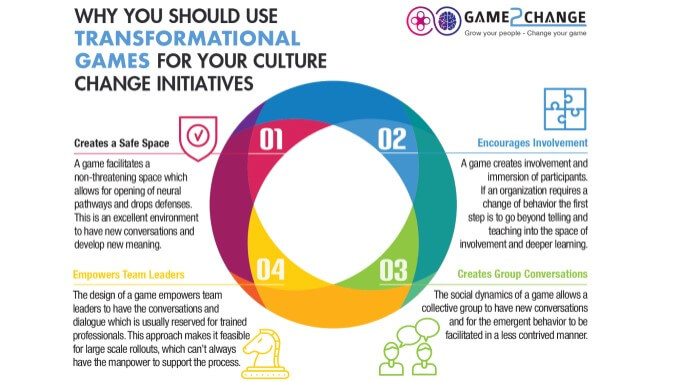
How a transformational game could foster more impactful results in a large-scale cultural change rollout.
The simple definition of culture is the way companies do things -it is the feel, the smell and the vibe you get when you walk into an environment of an organisation. Cultural change is deeply behavioural, if you want a new culture, it means you have to define a new way of being. Changing an organisational culture starts with changing individual behaviour – it has the daunting task of surfacing embedded beliefs and identity that inform the combined habits and collective behaviour.
This article will outline how a transformational game was a powerful tool in a cultural change initiative for a large international mining organisation. We will outline how it fitted and supported other change elements and the benefits derived from applying this approach.
When we consider this type of change, our starting points is to distinguish between diagnostic and dialogic approaches to organisational change. A diagnostic perspective is very appropriate when you do something that’s being planned – you know what the outcome is going to look like. An example may be the introduction of new technology and its adoption, there is a clear path to get buy-in, education and ultimately use.
Deep behavioural change requires a more dialogical approach, it is about constructing meaning and eliciting a new identity within the organisation. It seeks to challenge the status quo and ultimately a new way of “being” emerges which influences values and behaviours across the organisation. A dialogic change has an broad “end state” however the tempo and how the organisation is going to get there is not exactly defined and planned, furthermore the stakeholders inform the meaning of the end state.
Cultural change within a large mining organisation
A large, multi-national mining organisation embarked on a cultural change journey, with the intent to align its strategic intent with a cultural intent of significance, espousing a leadership style, values and employee engagement and shifting the culture from one of surviving to that of thriving. The 14 elements of the ideal culture were categorised into three pillars of:
(i) Leadership Values consisting of personal leadership, serving and supporting leadership, inspirational leadership and significant and Ubuntu leadership
(ii) Core Values of Safety, Accountability, Care and respect, Integrity, Collaboration and Innovation
(iii) Engagement Values from personal, team, job and organisational engagement
Each value was underpinned by a series of behaviours, with definition of how each would be demonstrated across all levels of the organisation.
How do you embed this change across multiple levels within an organisation of 25,000 people in dispersed locations speaking various languages ? When faced with this challenge, it was acknowledged that an innovative approach was required to work in an African context. These constraints led to finding a solution to enable a change dialogue with limited number of skilled change facilitators and which also could resonate with a diverse workforce. In this article we briefly discuss the overall design of the behavioural change and how a transformational game formed a key part of addressing the constraints and complexity.
Prior to unpacking the design, and benefits of the transformational game; it is important to place it in context of the overall change initiative and how it supported (and was supported by prior interventions). Any complex, large scale change intervention consists of multiple components supporting each other.
The First Stage in the Cultural transformation : Leadership Preparation
The cultural change required a new leadership style that was embedded, and even taught in the organisation. This wasn’t about the top 250 leaders; it was an inclusive style and was about any person in a role influencing somebody else. A standard leadership style was defined based on supporting the cultural change (and the renewed 14 components of the culture). A 360-leadership feedback tool measured and participants received feedback on how others perceived them on this style. This initial leadership journey was a series of small group sessions and was in preparation for the next phase of the cultural change. Due to the engaging nature of this intervention, the organised labour representation and leadership, were also included in the leadership development aspects.
The Second Stage : Workforce Engagement
This stage was about engaging the workforce. An important aspect of embedding this cultural change was to make sure that the correct language, symbols and metaphors were being used to get workforce buy-in. Although a central identity and culture for the organisation was the aim, there was also an appreciation for the diverse nature of the various operations. Different operations were therefore allowed to craft a unique metaphor or change journey to embed in the group culture, while accommodating the unique context. Each operation participated in discussions to select a suitable theme (conversation metaphor) these ranged from soccer (La Duma) to the big five animals representative of Africa – one such metaphor was “The Elephant”. Each operation selected a conversation metaphor which resonated with them, and workshop discussions allowed for the theme to be communicated and related back to the 14 culture elements. Language was an important part of communicating the theme, and each of the 14 elements had to be reflective of actual behaviour in the workplace and where possible weave in the conversation metaphor. As an example in the La Duma (soccer theme) the value of integrity was related back to how a referee would ensure the fairness of each game, and how this instils integrity in the sport.
Third Stage : Experiential Learning and Transformational Game
The conversation metaphors were communicated and understood across each operation and embraced by all. This was delivered with short impactful videos and workshop discussions hosted by change leaders in each operation. A transformational game was selected as the experiential tool to support and embed the behaviour change.
Why was a transformational game chosen ? A transformational game has the intention of changing the “player” (learner) rather than a focus on content or a topic (The Transformational Framework, Sabrina Culya, 2019). A transformational game which seeks to enable a behaviour change requires people to shift their mental paradigms; how they think. A well-designed transformational game can allow for participation which creates emotional connection while challenging mindset with non-threatening dialogue. The nature of play and social dynamic of a game opens neural pathways – we often refer to this space as the “magical circle” where structure and interaction of a game allows a new reality to be created. It leads to creativity and openness. This type of experience also brings new energy and motivation required to sustain the dialogue.
The transformational games were designed with the following criteria from the change sponsor and client :
- It needed to reflect and weave the conversation metaphor (theme) into the game narrative.
- It needed to be designed on a standard framework however still accommodate the nuances for each operation and their metaphor.
- The game design needed to encourage dialogue, not just light-hearted fun but also serious conversation.
- Due to the scale of the rollout, experienced change facilitators would need to upskill team leaders to facilitate the dialogue with their teams.
- The game design also required a degree of adaptability in terms of accommodating longer teaming sessions (one day) while also being able to be played in shorter on-the-job sessions such as meetings
- There needed to be clear outcomes and accountability following the session, which could be tracked over a period of time
The intention of the transformational game
We set about looking at the intent of the transformational game – to change individual stories, identity and ultimately shift behaviour within the business. When we brainstormed and tested different types of design, we realised that applying a mechanical approach of using game mechanics as triggers to drive behaviour, would not be suitable . Our intention was to rather design a framework which would create an environment to loosen mental constructs and encourage a new way of being to emerge through the experience.
The design elements of the transformational game
The change required deep learning, and therefore experiential and active learning was applied, incorporating all modalities from auditory, kinaesthetic, visual and tactile. Our anchor point of this design was three representative areas of (i) Head – How do I think about a value (ii) Heart – what is my feeling about this value (iii) Feet – how can I change my action (ultimately) my behaviour based on reflecting on my thoughts and feeling.
The game play was to foster excitement and energy, while encouraging collaboration and limited competition. A pathway was designed which required teams to journey through a cluster of 4 values, starting with head and heart scenarios, and culminating in feet activities and reflections. The gameplay was enriched with strong narratives of the conversation metaphor. This included a series of relatable scenario for each value, which was carefully crafted in consultation with operations and a test audience.
Game Play
The objective was to move along the pathway with a die roll, responding and progressing with thought provoking scenarios which would require a choice with motivation or an open-ended question. These forms of game quests and questions invited discussion and over time a dialogue evolved . The feeling of movement was created, and all teams were required to work collaboratively to progress through the scenarios. The surprise element was in how teams then decided to commit to change behaviour in the “feet” icon on the gameboard. As follow-up after gameplay, a leaderboard was framed as an action board with teams reflecting and then committing to on-the-job actions.

How was the transformational game delivered?
There were a series of four transformational game which utilised the same framework and gameplay and was played with four – five of the 14 values per game. Each three – four months a session was facilitated by team leaders either as a full day or half day session. In between the more formal sessions, shorter variances of the transformational game (in a spin-the-wheel) allowed for refresher sessions and a check-in on accountability actions.

1. Team Leader Led
The game was facilitated internally with little to no interference from external sources, this allowed for a non-threatening space to be created. This was an environment to foster more transparency and vulnerability for the reframing of personal stories and re-evaluating underlying beliefs. The benefit of internal facilitators also allowed for more contextual discussions related to the working environment and a sense of shaping the culture change. The guidelines and nature of the game environment, furthermore empowered the team leader as facilitator to open up deep conversation about behaviour in the workplace, that is typically left to behavioural experts or psychologists.
2. Designing relatable narratives within the game journey
Each transformational game had a theme and story (conversational metaphor) selected from the operations and across all stakeholders. This element created involvement and immersion of participants (elements of storytelling). Going beyond telling and teaching into the space of involvement and deeper learning.
3. Sustainability
Delivering the transformational games as a series of interventions which could be facilitated in both formal (teaming sessions) and on-the-job sessions, allowed for a gradual embedding of a new way of being in the workplace. Deep learning and shifting of mental paradigms require multiple sessions, this approach allowed for feedback loops to be created between formal sessions, and temperature checks of general sentiment with the accountability board.The transformational game empowered the team leaders to have the conversations and dialogue which are usually reserved for trained professionals. This approach made it feasible for this large scale rollout.
The transformational game received positive feedback, and certainly empowered each change champion to deliver on their mandate. Here are a couple of insights from people participating in the transformational games :
- This approach is not a top-down-listen-to-the-leader approach, but it is about participation of all members, where all have a voice and viewpoint that can benefit the rest of the team.
- It encourages participation, engagement and the desire to transform our behavior as individuals and teams.
- It is not about who is right and wrong, but about what we can learn from each other. We all have learned so much in life and this we can share with other in terms of our desired behavior.
- I was surprised about the levels of wisdom in the room and how sometimes academic jargon on desired behaviours got translated into practical language and application in work, life and play
- I was surprised to see how team dynamics have changed for the better, how teams become more engaged with one another, and how collaborative conversation, instead of me-know-it-all conversations are taking place.
Adjusting to an Online World
Since this cultural change initiative was embedded in the organisation in 2019, many changes have impacted our world. At Game2Change we have reviewed and recalibrated how we can foster dialogue in a virtual world, and still capture the magic circle which leads to shifting stories and ultimately behavior. One of our key insights in interviewing learners, is the power of writing scenarios which capture imagination and can trigger dialogue. We are exploring how you can capture the “stories” of a culture and design for an immersive setting such as online game journeys and live synchronous sessions. The power of technology will make a transformative game more scalable and impactful in the near future. To learn more about our work and how we have applied transformational games and gamification, especially in emerging and developing markets such as South Africa and Africa – visit our website : www.game2change.com
- Behavioural Change through Transformational Games - 12th May 2021
- How To Foster Virtual Environments For Your Dream Team To Thrive. - 17th June 2020
- Behavioural Change through Transformational Games - 12th May 2021






I saw a reference to this article on LinkedIn through Natasha who is a personal friend and it piqued my interest. Well done on your creation and successes